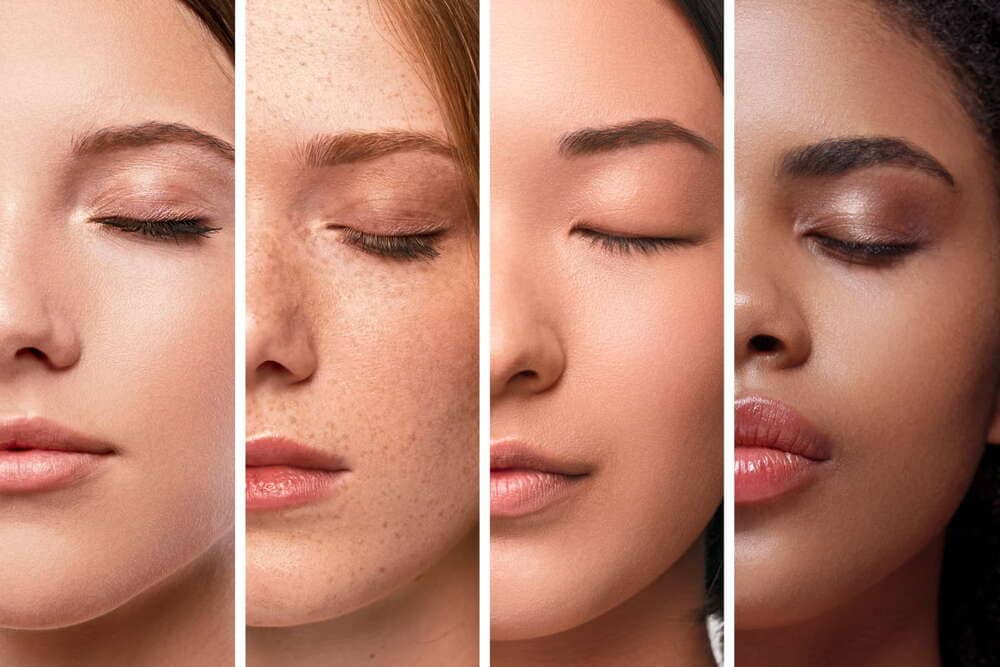
Have you ever wondered what your skin type is and how it affects your daily skincare routine? This is an important topic, and knowing your skin type can make all the difference when choosing the right products. However, many people still have doubts about this subject, especially since everyone’s skin can be quite different.
In this article, we will explore the different skin types, how to identify them, and what care each type needs to stay healthy and beautiful. Whether you’ve never thought about it before or have questions about how to identify your skin type, don’t worry. I will explain everything in a simple and clear way.
What Are Skin Types?
A skin type is an individual characteristic that can vary from person to person. What does this mean? In simple terms, everyone’s skin has specific needs. These needs depend on factors like genetics, diet, environment, and even the use of certain products. Knowing your skin type will help you choose the right products without harming your skin.
There are five main skin types. Let’s take a closer look at each one.
Skin Types
1. Normal Skin
Normal skin is, let’s say, the “balanced” skin type. It’s neither too oily nor too dry. This skin type has a smooth texture and usually doesn’t face many problems, like acne or dryness. People with normal skin generally don’t experience frequent irritation or tightness.
Characteristics of Normal Skin:
- Not oily or dry.
- Smooth and soft surface.
- Small pores with little tendency to acne.
- No frequent redness or irritation.
2. Dry Skin
Dry skin can feel rough, flaky, and often gives a tight feeling, especially after a shower or washing your face. This skin type is less able to retain moisture, which makes it more prone to irritation and redness. Cold weather or lack of proper hydration can worsen the condition.
Characteristics of Dry Skin:
- Tight or flaky feeling, especially after washing the face.
- May show cracks, itchiness, or peeling.
- Smaller pores.
- Tendency to feel rough or dull.
Care for Dry Skin:
- Use rich, thick moisturizers.
- Avoid harsh soaps.
- Apply a good sunscreen, as dry skin can be more sensitive.
3. Oily Skin
Oily skin tends to shine throughout the day, especially in the T-zone (forehead, nose, and chin). This happens because the sebaceous glands produce excess sebum. While oily skin tends to be more resistant to premature aging, excessive oil can lead to acne and other skin issues.
Characteristics of Oily Skin:
- Constant shine, especially in the T-zone.
- Enlarged pores and visible.
- Tendency to have acne, blackheads, and pimples.
Care for Oily Skin:
- Use products formulated for oily skin, such as astringent cleansers.
- Avoid heavy creams; opt for gel moisturizers.
- Wash your face frequently to control excess oil.
4. Combination Skin
Combination skin is a mix of characteristics from both oily and dry skin. It may be dry or normal on the cheeks and other parts of the face, but show oiliness in the T-zone (forehead, nose, and chin). This skin type requires special care to balance out the different areas of the face.
Characteristics of Combination Skin:
- Oily in the T-zone.
- Dry or normal in other areas of the face.
- Enlarged pores, especially in the T-zone.
- May be tricky to care for, as it needs different products for different areas.
Care for Combination Skin:
- Use balanced products that treat both oily and dry areas.
- Choose light moisturizers to avoid overloading the oily areas.
- Use a gentle cleanser to balance sebum production.
5. Sensitive Skin
Sensitive skin is more prone to adverse reactions, such as redness, stinging, and itching. This can be caused by various factors, like using the wrong products, allergies, or even environmental factors like wind or extreme cold. Sensitive skin requires gentle care with products that won’t cause irritation.
Characteristics of Sensitive Skin:
- Easily irritated, with redness or discomfort.
- Prone to stinging or burning sensations.
- Reacts badly to certain products, such as cosmetics or soaps.
- Often feels dry or flaky.
Care for Sensitive Skin:
- Use hypoallergenic, fragrance-free products.
- Keep the skin well-hydrated to prevent dryness.
- Avoid prolonged sun exposure without protection.
How to Identify Your Skin Type?

Now that you know the different skin types, you might be wondering: “How do I know which one is mine?” Here’s a simple way to figure it out:
- Clean your face: Use a gentle soap or cleanser and wash your face with warm water.
- Let your skin dry naturally: Avoid applying any products for at least an hour.
- Observe how your skin reacts:
- Normal skin: Comfortable, not too oily or dry.
- Dry skin: Tight, rough, or flaky.
- Oily skin: Shiny, especially in the T-zone.
- Combination skin: Oily in the T-zone, dry in other areas.
- Sensitive skin: Red, irritated, or stinging.
General Care for All Skin Types
Although each skin type has its specific needs, there are general care tips that can benefit all skin types:
1. Cleansing
Daily cleansing is essential to remove dirt, pollution, and makeup residues. No matter your skin type, choose a gentle cleanser suited for your skin’s needs.
2. Moisturizing
Moisturizing is important for all skin types, even oily skin. The difference lies in the product: those with oily skin should opt for lightweight gels, while dry skin needs thicker, more nourishing creams.
3. Sun Protection
Sunscreen is crucial for all skin types. Whether it’s sunny or cloudy, the sun can cause premature aging, spots, and even skin cancer. Make sunscreen a daily habit, regardless of your skin type.
Frequently Asked Questions (FAQ)
1. How can I know my skin type?
To discover your skin type, simply follow this easy test: Wash your face with a gentle cleanser and let your skin dry naturally for about an hour. Then, observe how your skin feels:
- Normal skin: Not too oily or dry.
- Dry skin: Tight or flaky.
- Oily skin: Shiny, especially in the T-zone.
- Combination skin: Oily in the T-zone, dry in other areas.
- Sensitive skin: Red, irritated, or stinging.
2. Can I have more than one skin type on my face?
Yes! Many people have combination skin, which means that the T-zone (forehead, nose, and chin) may be oily, while the cheeks and other parts of the face may be dry or normal. In such cases, you’ll need to use different products for different areas of your face.
3. Can my skin type change over time?
Yes, your skin type can change over time due to factors like hormones, weather, diet, and the use of certain products. For example, during adolescence, many people have oily skin, but over time, this can change, and skin may become drier or more normal.
4. How do I choose the right moisturizer for each skin type?
- Dry skin: Choose thick, rich moisturizers with ingredients like hyaluronic acid or ceramides.
- Oily skin: Opt for gel-based or lightweight moisturizers that help control oil without clogging pores.
- Combination skin: Look for balanced products that treat both oily and dry areas.
- Sensitive skin: Choose hypoallergenic, fragrance-free products to avoid irritation.
5. Is sunscreen important for all skin types?
Yes! Sunscreen is essential for all skin types. Even people with oily or combination skin need sunscreen daily. The sun can cause premature aging, spots, and even skin cancer, so make sunscreen a part of your routine every day.
6. Can I use the same products for my face and body?
Although some products can be used for both face and body, it’s better to choose face-specific products since facial skin is more delicate. Additionally, facial skincare needs are different from body skincare needs.

Key Takeaways:
- There are five main skin types: normal, dry, oily, combination, and sensitive.
- Each skin type has specific characteristics and needs.
- Identifying your skin type is essential for choosing the right products.
- Cleansing, moisturizing, and sun protection are essential for all skin types.
Now that you know more about skin types, why not start taking better care of your own? If you need help choosing the right products for your skin, feel free to reach out. Your skin deserves the best care!
Conclusion
Understanding your skin type is the first step to taking good care of it. Whether you have normal, dry, oily, combination, or sensitive skin, knowing your skin’s needs will help you choose the right products for a healthy, glowing complexion. Remember, taking care of your skin doesn’t need to be complicated. With the right information and products, you’ll be able to achieve great results.
Author’s Vision
Hello! I’m someone passionate about understanding how the skin works and how to take the best care of it. I’ve gone through many discoveries in my own journey, trying to understand my own skin’s needs, and now I want to share that knowledge with you.
I believe skincare doesn’t need to be complicated. Everyone deserves healthy, happy skin, and the first step is understanding your

2 thoughts on “Skin Types: Understand the Differences and How to Care for Each One”